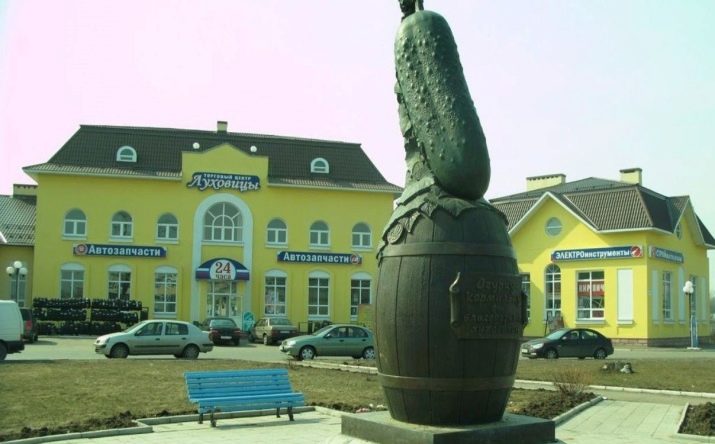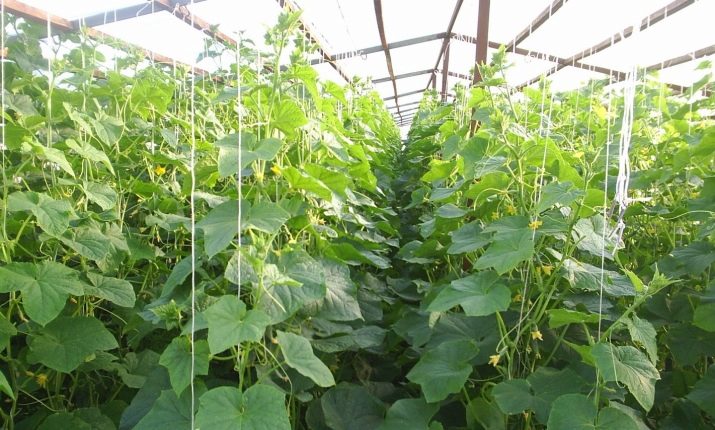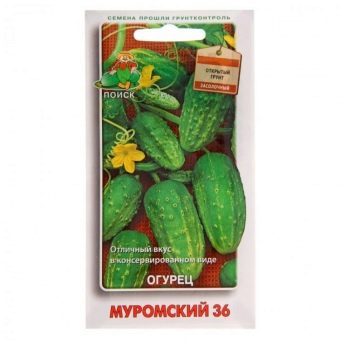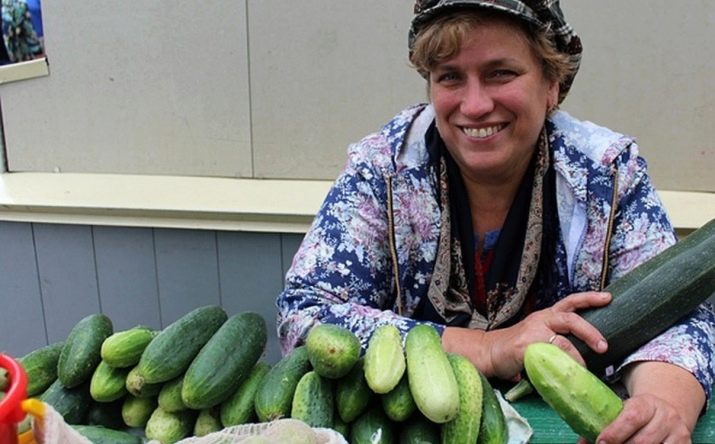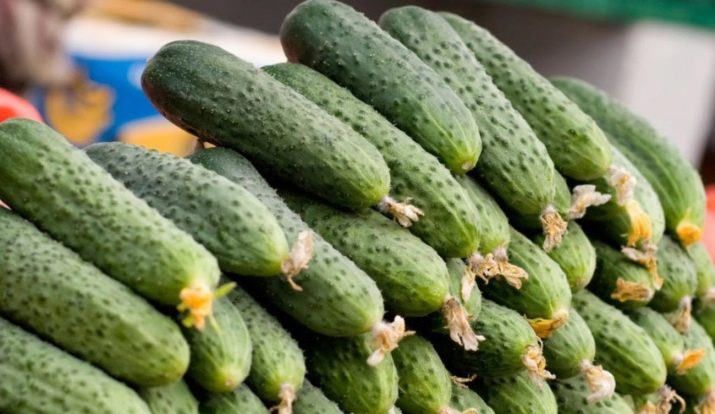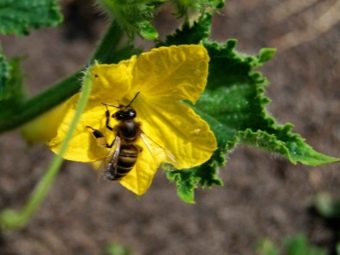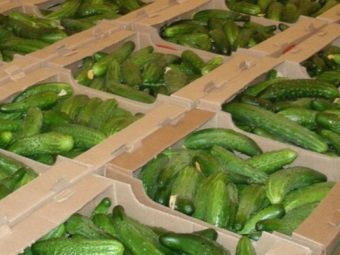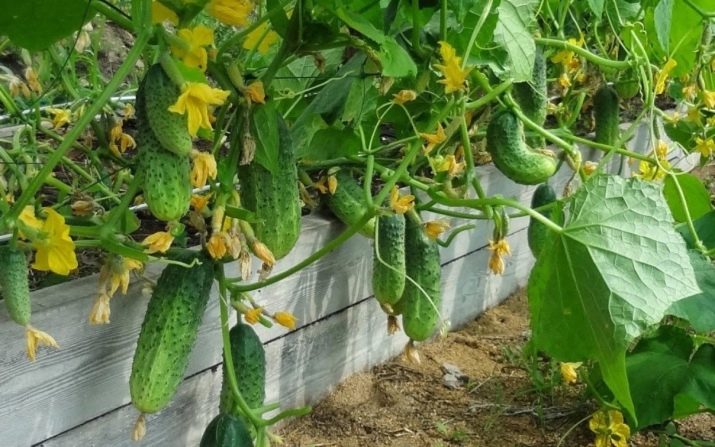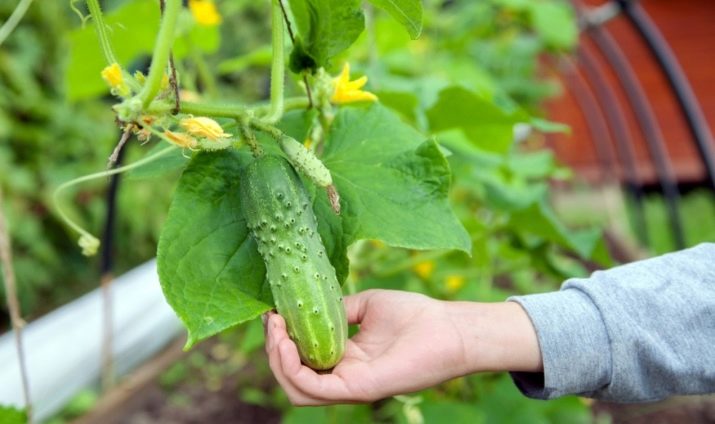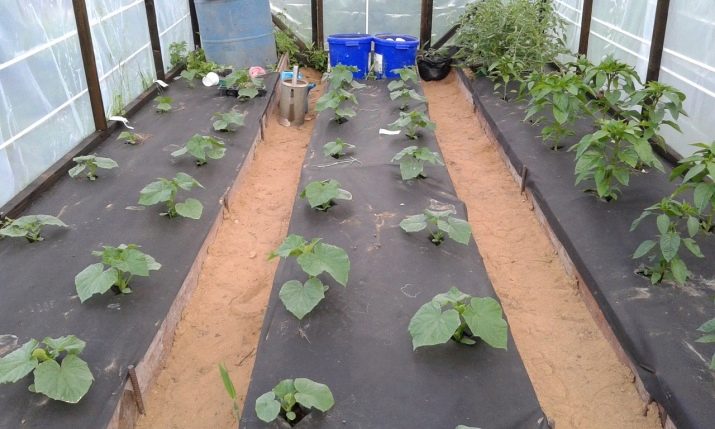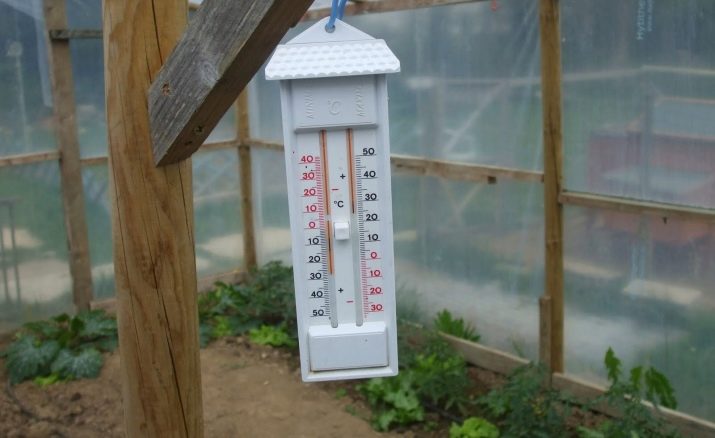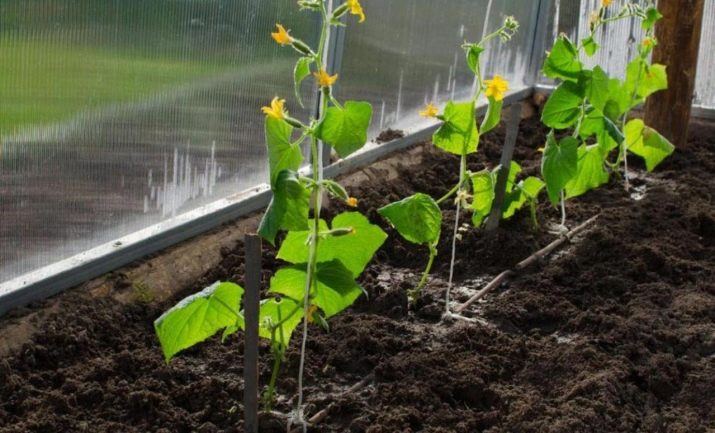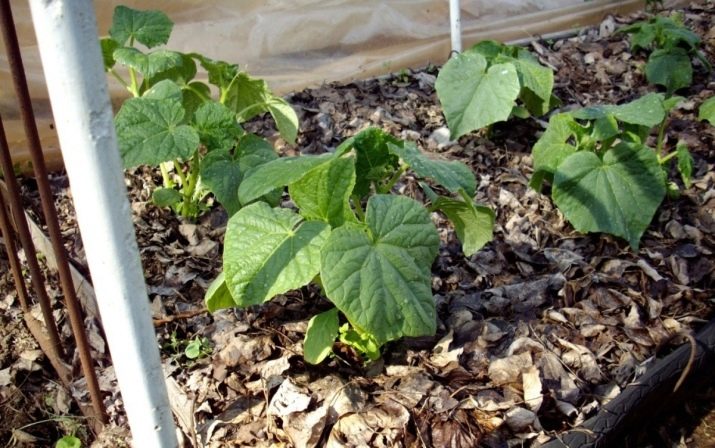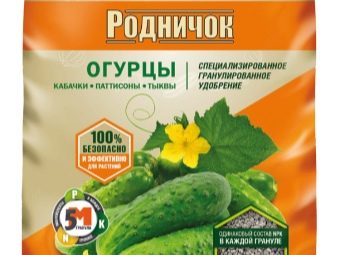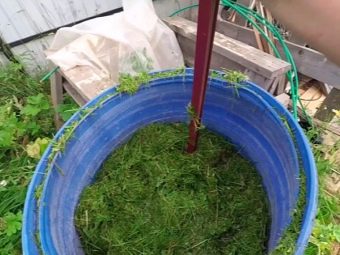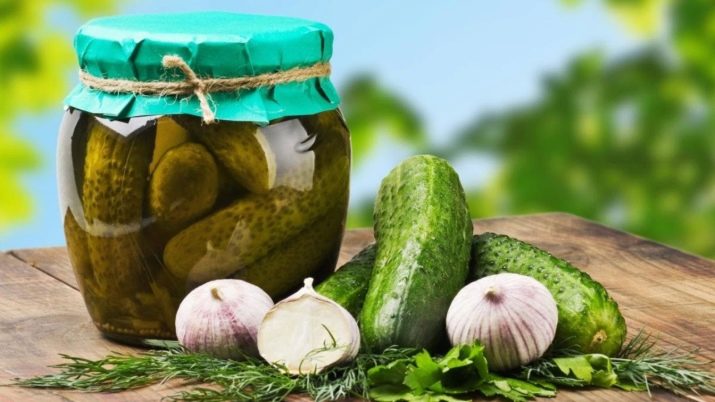F1 Lukhovitsky cucumbers: characteristics of the species and cultivation
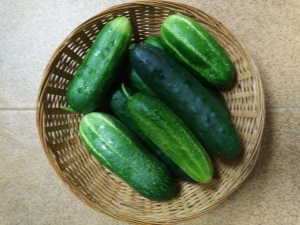
A barrel with a cucumber lying on it - such a monument was put in the center of the town of Lukhovitsy to this tasty vegetable. The inscription on the monument reads: "The cucumber from the grateful lukhovichan."Locals are very kind to Zelentsa, they even created a museum dedicated to culture.
A bit of history
Homeland cucumber is India, where the vegetable began to grow even in the III millennium BC. e. Later, it became popular in Egypt and Greece, and cucumbers were brought to Russia in the 15th century. Now in our country, this culture is grown everywhere and is in demand. It is planted on a large scale on an industrial scale and in summer cottages, both in open ground and in greenhouses.
Before the Great Patriotic Revolution of 1917 in the Moscow region, the peasants were mainly engaged in crafts, animal husbandry and fishing. With the advent of the new government in the floodplain of the Oka River, they began to produce a massive plowing and distribution of land to local residents, who began to grow various vegetable crops. The owners of the land paid attention to the fact that of all the planted vegetables, cucumbers grow best and bear fruit. Every year on their plots the villagers selected the most fruitful plants, so there appeared varieties, which in our time are known to all as “Lukhovitsky”. In the fifties of the twentieth century, many varieties were counted among them, currently the most popular of them are “Vyaznikovsky”, “Muromsky”, “Mirinda”, “Libella”, “Elegant”.
More recently, domestic breeders introduced a new variety - “Lukhovitsky cucumber F1”, which has all the historically established characteristics of cucumbers from Lukhovits near Moscow. The variety is early ripe, having a female type of flowering. With one square meter you can harvest up to 10 kilograms.
In Lukhovitsy, residents grow cucumbers according to their developed technology. In addition, they respect their vegetable culture. Picked cucumbers immediately go on the shelves for sale. Traders from neighboring areas decided to take advantage of the Lukhovitsky varieties. For this reason, the Administration of Lukhovitsky District decided on a patent for fruits grown on this land. Now all their farmers receive certificates to confirm the territorial affiliation of cucumbers.
Characteristics of popular varieties
Lukhovitsky cucumbers are known throughout Russia and are very fond of the peculiarities inherent only to them:
- small identical size (from 7 cm to 13 cm);
- pronounced pleasant tastes;
- lack of bitterness, high density and thin delicate skin;
- crunch while eating both fresh and pickled cucumbers;
- attractive appearance (fruits of a cylindrical form, tuberculate, with characteristic pimples).
All varieties Lukhivitsky cucumbers have the same characteristics:
- short vegetative period, which ranges from 45 to 60 days (depending on the variety) from the moment of emergence to the beginning of the harvest;
- pollination is carried out by bees;
- there is immunity to many diseases;
- plants successfully tolerate short-term cooling;
- varieties are available for cultivation in the northern regions of the country;
- fruits well withstand transportation;
- Cucumbers give a good harvest both in the open and in the closed ground.
Consider Lukhovitsky varieties in more detail.
Cucumber "Vyaznikovsky" bred by breeders in the 19th century; Vladimir and Moscow regions are considered to be his homeland. The variety is included in the collection of the All-Russian Institute of Genetics Resources. Early ripe Zelenets ripens in 45 days, yields high yields (up to 3.5 kg is collected from 1 sq. M), whips grow of medium length (from 1.6 to 2 m).
"Murom" - ultra-early variety, harvest time comes within 5 weeks after germination. The variety does not suffer from powdery mildew, bacteriosis. Scourge grow small, their length does not exceed one and a half meters. On the central trunk are male flowers, and on the side - female. The plant is not afraid of cold, but does not like hot weather. Productivity is low.
Fruits of the variety "Miranda" formed without pollination. The plant is branched, has a strong stalk, whips grow to 4 meters.The variety is resistant to cladosporia, has a high yield (6.3 kg of fruits are harvested from 1 square meter).
Feature of the variety "Libella" is a very large number of ovaries. During the summer season there is an accelerated growth of the stem, it is very sprawling. Fruit ripening occurs one and a half to two months after the emergence of shoots. Productivity is high (experienced gardeners collect up to 10 kg per sq. M.).
Sort "Elegant" refers to the early maturing. The vegetative period is only 50 days, the yield is high - up to 7 kg per 1 square meter. The peculiarity of the variety is that a lot of male flowers bloom on the bush, which can be used for pollination of other varieties.
Growing secrets
The quality of Lukhivitsky cucumbers, first of all, is influenced by the special oily soil and microclimate of the lower reaches of the Oka River. Here, climatic conditions are characterized by high humidity and a rather large frost-free period. Lukhovitsy cucumbers love fertile soil, a large amount of sunlight and the absence of wind. Cucumber "Lukhovitsky F1" and its green counterparts are grown according to a special technology worked out over the years by Lukhovichans. It is inherited from generation to generation.
Before the onset of winter, a trench is dug 1 m wide and at least 40 cm deep. On the sides of the trench lined with wooden boards with a height of 25 cm. In the spring for the destruction of pests the bottom and side of the trench is poured over with boiling water and covered with plastic wrap. Then the film is poured with sawdust with urea and put a layer of manure, which is filled with fertile soil. This layer is about 12 cm thick. A dark film is laid on top. A few days later it makes holes for planting seedlings.
Planting of cucumbers is carried out in early spring, when the snow had not yet descended. In large greenhouses, straw is placed on the bottom, which is covered with earth mixed with peat and humus. Before planting, seeds are soaked for a few days for pecking. As soon as the roots appear, the seeds are immediately planted in a greenhouse and covered with foil. The straw at the bottom of the greenhouse begins to rot and thereby gives off its heat to the young seedlings. In the greenhouse, they begin to carry out the feed after the plant has formed three full leaves.
In greenhouses it is necessary to withstand a certain temperature.
In early spring, warming of greenhouses should be envisaged, since at night the temperature can drop to 0 ° C.
Additional insulation must be maintained until the outside air temperature is above 16 ° C. When the temperature rises above 25 ° C, regular airing should be carried out.
Planting in open ground is made in early June, after the earth warms up well, and there will also be confidence that the frost will not occur. In the prepared trench seedlings are planted, which already has four leaves. Transplantation is done very carefully. In no case can the root system be injured, such plants no longer take root. Cucumbers are planted in poured holes at a distance of half a meter from each other.
The technology of planting in the holes of the film contributes to protection from cold weather and the appearance of weeds. Airing is regularly carried out (film is removed and covered again), and watering is performed once a week.
Cucumbers on the beds require special care, as their root system is very close to the ground, therefore, with ordinary loosening, the roots of a vegetable are badly injured. In this case, the plant may die. The best way to ensure the air exchange of the soil is to carry out mulching and regular application of organic fertilizers.
Cucumbers are plants that love moisture, so watering must be given special attention. As soon as the earth begins to dry, it is necessary to moisten the soil. During fruiting, watering should be increased, because a lot of water is needed to form the fruit.
Top dressing should be carried out during the whole summer season if organic fertilizers have not been applied during planting. To get a good harvest, plants should be fed with nitrogen, phosphate and potash fertilizers.
You will learn more about the secrets of growing Lukhovitsy cucumbers by watching the following video.
Reviews
Anyone who has ever tried Lukhovitsky cucumbers, speaks well of their taste. Therefore, these cucumbers are famous not only in the Moscow region, but throughout Russia. Judging by the numerous reviews of gardeners growing a new hybrid Lukhovitsky F1, this variety imitates very well the fruits that have been grown for many years in the lower reaches of the Oka.
You can buy real Lukhivitsi cucumbers only in the markets of Moscow and Moscow region, and, of course, in Lukhovitsy themselves. This small town is located 135 km from Moscow along the Moscow-Chelyabinsk road. Here you can enjoy both fresh crunchy cucumbers and salted. Locals prepare special, incredibly tasty salted and pickled vegetables, taking for pickling fruits no larger than 10 cm.

